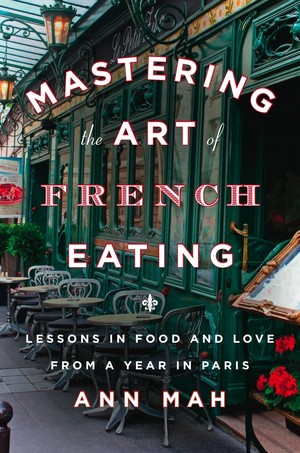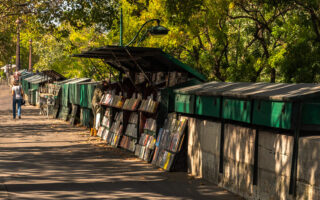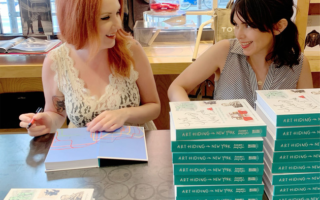Book Review: Mastering the Art of French Eating

- SUBSCRIBE
- ALREADY SUBSCRIBED?
BECOME A BONJOUR PARIS MEMBER
Gain full access to our collection of over 5,000 articles and bring the City of Light into your life. Just 60 USD per year.
Find out why you should become a member here.
Sign in
Fill in your credentials below.
 Generally, I distrust most food memoirs. There seems to be a widespread acceptance of embellishing and toying with events in order to massage the material into a cogent narrative. While that’s understandable, sometimes I suspect the narrative has been slanted in a way that seems less about good storytelling than making the author come off as intelligent, perceptive, and ever-so-savvy at every turn. Or, I suspect, to make those precious food moments more life-altering than they actually were.
Generally, I distrust most food memoirs. There seems to be a widespread acceptance of embellishing and toying with events in order to massage the material into a cogent narrative. While that’s understandable, sometimes I suspect the narrative has been slanted in a way that seems less about good storytelling than making the author come off as intelligent, perceptive, and ever-so-savvy at every turn. Or, I suspect, to make those precious food moments more life-altering than they actually were.
How delightful it is, then to read Ann Mah’s wonderfully frank and refreshingly not self-aggrandizing memoir, “Mastering the Art of French Eating: Lessons in Food and Love from a Year in Paris” (Pamela Dorman/Penguin; $25.95).
Mah and her husband, Calvin, get oh-so close to living the dream: His career as a diplomat lands them a 3-year stint in Paris. It’s a perfect set-up for Mah, a journalist, who plans to spend the heaven-sent stretch of time finishing her second novel, while she and Calvin work their way through the “patisseries, chocolatiers, charcuteries, fromageries, boulangeries, caveists” of their “city of dreams.”
Hardly have they unpacked, however, when the couple get the call: Calvin is assigned a one-year post in Iraq; spouses are not to follow. With few friends and not a whole lot to do, Mah’ finds herself alone in the city she had dreamed of savoring à deux.
Still, she’s in Paris—with plenty of time, a novel to write, and seemingly few worries about how she’s going to make rent. How bad can that be?
 Alas, soon, the weight of solitude bears down on Mah. Though she finds a part-time job at the American library, which gives her some structure and the occasional lunch companion, the highlight of her evenings are the Skype chats she schedules with her husband; after that, it’s a dinner of toast in front of the computer and hours of insomnia.
Alas, soon, the weight of solitude bears down on Mah. Though she finds a part-time job at the American library, which gives her some structure and the occasional lunch companion, the highlight of her evenings are the Skype chats she schedules with her husband; after that, it’s a dinner of toast in front of the computer and hours of insomnia.
And the novel she’s writing? Indeed, she has a ritual: Mornings find her making herself a cup of tea, sitting down at her computer, and … logging into Facebook.
“Ever since Calvin’s departure…, my discipline had been washed away by a sea of cat videos,” she writes.
Hers is a quiet, non-heroic kind of pain (first-world problems, we might say), and Mah is the first to recognize this. Yet that’s part of the loveliness of this memoir. Rather than mining for obvious, sweeping dramas, she does the more resonant work of articulating the insistent ache we experience when we are lonely and unsure of ourselves, when—in spite of our (mostly) good fortune, we find ourselves tearful on the Metro in the most beautiful city in the world.
To combat her sadness, Mah gives herself an assignment: She’ll crisscross France, seeking out the stories behind the country’s most famous regional dishes, from choucroute in the northeast to cassoulet in the Southwest; from crêpes in Brittany to soup au pistou in Provence.
In this way, the solution to her non-heroic problems becomes, in fact, quite heroic. After all, it would be much easier for Mah, who describes herself as inherently shy, to stay home watching cat videos than to travel alone through unfamiliar terrain, seeking out and interviewing (in her admittedly imperfect French) top experts in their field.
What’s especially admirable is how this somewhat self-effacing woman intrepidly gains access to the very people who may know the most about the food she’s exploring. In Troyes, she gets inside laboratories and factories of andouillette producers. In Paris, she descends into the tiny basement workshop where a famed steak-frites restaurateur cuts and ages his steaks. In Provence, she chops and peels vegetables alongside the locals as they prepare for the Fête de Soup au Pistou à Bonnieux.
These and other feats are extraordinary inroads in a country whose citizens are especially sensitive about their privacy. As Mah writes, “asking to join [my acquaintance] in her kitchen was like asking if I could help her clean out her closet.”
So we travel alongside Mah as she meets chefs, farmers, and restaurateurs, picking up history, insights, and cooking tips along the way. She uncovers nuggets that even veteran American Francophiles may not know. And even if you did know, for example, that the Aveyronnais from la France profonde are responsible for the proliferation of the Parisian cafés (which, by the way, I did not know), you’ll love the fresh, vivid ways in which she describes touchstones of our Francophilia.
When a waiter in Burgundy rattles off the region’s famed wines that are served by the glass, “It felt like a celebrity sighting.” Brittany’s cooks recite crêpe recipes from memory, “like a favorite poem or prayer,” while their buckwheat crêpes resemble “dark, shining lace…against clean white porcelain.” Again and again Mah reminds us why we love France, from “surprise glimpses of Notre Dame caught from the bus,” to “the small cups of coffee garnished with a paper-wrapped sugar cube” at the café.
Adding to the charm of the memoir is Mah’s small #fails here and there. Dining with a French friend, she politely declines a taste of his andouillette, finding its smell reminiscent of “a cow-pasture. Or a baby’s unchanged diaper. Or one of Paris’ narrow, dog-friendly sidewalks.” Her friend, in turn, looks at her “as if I’d shown him my inner core and it was soft like a coward’s.”
Even after she travels all the way to Troyes to learn more about this famed tripe sausage, she can barely stomach it. Likewise, her French friends in the Aveyron take only a polite bite or two of the pumpkin pie she’s so painstakingly made for them.
And yet, the very fact that Mah does not triumph at every turn makes the reader root for her even more.
Towards the end of her story, Mah quotes another American in France, Thomas Jefferson, who wrote, “One travels more usefully when they travel alone, because they reflect more.”
Indeed. Through Mah’s travels—wrought with so much solitude—she unlocks gripping insights into the treasures of France, which she so generously shares with us.
Wini Moranville is the author of The Bonne Femme Cookbook: Simple, Splendid Food That French Women Cook Every Day and The Braiser Cookbook. Follow her website at Chezbonnefemme.com.
More in Ann Mah, book review, Paris book reviews, Paris books


